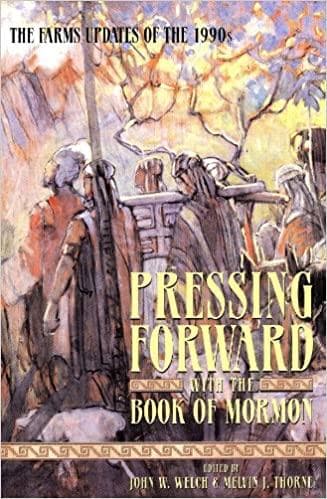Book
69 Chapters

Abstract
“But behold, king Benjamin gathered together his armies . . . and he did fight with the strength of his own arm, with the sword of Laban.” (Words of Mormon 1:13)
The sword that Nephi took from Laban played an important role in Nephite history, not only as the model after which the Nephites later made swords to defend themselves, but also and perhaps more importantly as a symbol of the legitimate authority of the Nephite rulers, beginning with Nephi himself.
Many histories and traditions have used weapons as symbols of royalty and authority. Swords in particular have had cultic importance in almost every culture. Gordon Thomasson has pointed out that the sword of Laban as a symbol of rule among the Nephites fits a long tradition, often portrayed in royal and religous art.1 Most of these symbolic swords can be categorized as either kingly or heroic swords.
In the kingly pattern, the sword helped to establish the possessor as the ruler, the one on whom divine kingship was conferred. It symbolized his responsibility to protect the society and to mete out justice. It originated with a deity and ratified the king’s office. The sword was passed on to the heir as a transfer of authority, and the giving of the sword to the new king was a widespread feature of coronation ceremonies.
The heroic pattern, found mainly in literature and mythology, established the possessor as one invested with divine authority for some holy quest or heroic deed. The sword was more than a weapon, giving the hero extra power and the blessing of the gods. For example, Beowulf used magical swords to overcome the monster Grendel.
In some tales, elements from both the kingly and the heroic combine to symbolize complete divine kingship and authority. For example, King Arthur drew Excalibur from the stone, which symbolized his divine right to kingship and gave him power to defeat the Saxons. David is another example, as he took Goliath’s sword and cut off the Philistine’s head. That sword was preserved and revered as it was kept with the ephod and priestly garments. David later obtained the sword again and heroically led the Israelites against the Philistines and later became king.
Like David, Nephi used the sword of Laban to cut off the head of its owner. This act led to his obtaining the records and helping to lead his people to a promised land, where he was made ruler. He apparently passed the sword to his successors, for it was used later by King Benjamin when he “did fight with the strength of his own arm, with the sword of Laban,” to defend his people against the Lamanites (Words of Mormon 1:13). King Benjamin passed the sword to his son Mosiah along with other sacred objects when he transferred “charge concerning all the affairs of the kingdom” (Mosiah 1:15; see also v. 16).
Even after the reign of kings came to an end and judges began to rule, the “sacred things,” which apparently included the sword, were passed on amongst the judges or the prophets as a symbol of divine authority. Even though the sword is not mentioned, textual clues show that it was probably still part of the sacred implements of authority.
When Alma passed the sacred treasures to his son Helaman, he explained:
And now remember, my son, that God has entrusted you with these things, which are sacred, which he has kept sacred, and also which he will keep and preserve for a wise purpose in him, that he may show forth his power unto future generations. (Alma 37:14)
Clearly the records were intended for a future generation, but was the sword intended to have some purpose at a later time?
In the restoration of the Church of Jesus Christ to the earth through Joseph Smith, the sword of Laban appears to have provided an additional witness to the Prophet’s divine authority. There is no direct evidence as to whether Joseph Smith ever possessed the sword of Laban, but it was part of the sacred relics along with the plates revealed by Moroni. Some of Joseph’s contemporaries thought that he did possess and even use the sword, which belief clearly lent legitimacy to his authority in their minds. This is also shown in connection with the famous “cave story” by Brigham Young and authenticated by others, where the sword of Laban was seen in a cave along with piles of plates.
In Nauvoo Joseph was prophet, mayor, and lieutenant governor of the Nauvoo Legion and held the three kingly roles of priest, civil administrator, and military leader. In the view of the Saints, Joseph was their leader and held the implements of divine authority, including the sword of Laban. As it had been with the Nephites, the sword of Laban was a symbol of the Lord’s authority and kingship in the latter days and showed “forth his power unto future generations.”
Research by Brett L. Holbrook, originally published as a FARMS Update in Insights (May 1993): 2. For further information, see Brett L. Holbrook, “The Sword of Laban as a Symbol of Divine Authority and Kingship,” Journal of Book of Mormon Studies 2/1 (1993):39–72.
Note
1. See Gordon C. Thomasson, “Mosiah: The Complex Symbolism and Symbolic Complex of Kingship in the Book of Mormon,” Journal of Book of Mormon Studies 2/1 (1993): 25–32.
Book
69 Chapters
Items in the BMC Archive are made publicly available for non-commercial, private use. Inclusion within the BMC Archive does not imply endorsement. Items do not represent the official views of The Church of Jesus Christ of Latter-day Saints or of Book of Mormon Central.